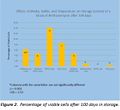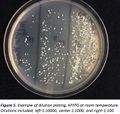Brettanomyces Storage Survival Experiment
This page documents an experiment by Mark Trent to investigate the long term (100 days) survival rates or Brettanomyces under different media and temperatures. Further work is required to verify these results. Richard Preiss of Escarpment Laboratories is working on similar research, and Mark Trent intends on evaluating this experiment again.
Contents
[hide]Introduction
Survival of yeast in 4 different liquid media preparations was tested in cold and room temperature conditions. Media were; wort, buffered wort, MYPG, and buffered MYPG. In addition yeast was stored cold on solid media plates and slants containing buffered MYPG or MYPG. For liquid media, the yeast survived better at room temperature conditions compared to refrigerated conditions with the exception of survival in buffered MYPG cold treatment which was not significantly different from survival in buffered wort room or in buffered MYPG room (Fig. 2). Yeast stored on plates were dead on both media as was the yeast stored on MYPG slants while the yeast stored on buffered MYPG "slants" was viable in both replicates (Fig. 4).
Materials and Methods
A strain of Brettanomyces isolated from Orval was inoculated into 4-250ml flasks containing either buffered MYPG, MYPG, buffered wort, or wort and incubated at 26°C on an orbital shaker at 80rpm for 60hrs. MYPG was prepared according to the methods of Chad Yakobson and was at a calculated gravity of 1.005. Wort was prepared from canned wort that had been mashed and cleared by traditional homebrew methods and was at a measured gravity of 1.04. For the buffered treatments, CaCO3 was added at 20g per L. Yeast cells from each culture were counted using a hemocytometer and 7ml aliquots of each culture were placed in a 15ml plastic centrifuge tubes for each treatment. Treatments were arranged in a completely randomized design and included Buffered MYPG-cold, Buffered MYPG-room, Buffered Wort-cold, Buffered Wort-room, MYPG-cold, MYPG-room, Wort-cold, and Wort-room. Cold treatments were held in a home style refrigerator at 1°C and room treatments were held in a closet that varied from 16 to 22°C. All treatments had 2 replicates. Data is represented as the percentage of live cell based on the original cell count of each inoculum source and the number of colonies that grew and were countable after dilution. The results were analyzed using Agstats02 (http://pnwsteep.wsu.edu/). After 100 days in storage, 100µl were sampled from each replicate and serial dilutions were made to 1:100000. Ten µl aliquots of the 1:100, 1:1000, and 1:10000 or 1:1000, 1:10000 and 1:1000000 dilutions were spread onto approximately 1/3 of a petri dishes containing MYPG solid media for each replicated treatment and subjected to 5 days incubation at 26°C (Fig. 5). Visible colonies were counted and the number of viable cells were calculated.
In addition, slants and plates were made by adding agar to the Buffered MYPG and MYPG media and were streak inoculated with the same strain of Brettanomyces. Plates were 100 x 15mm plastic petri dishes and slants were 15ml centrifuge tubes. Both plates and slants were incubated at 26°C until growth had covered the surface of the slants or 1mm colonies had formed on the plates. The plates were wrapped with electrical tape and the two replicates of each treatment were stored at cold temperature at 1°C. After 100 days in storage, a small amount of yeast from a single colony (plates) or spread (slants) was spread onto ½ of a petri dish containing MYPG solid media for each replicated treatment and subjected to 5 days incubation at 26°C. Only live/dead observations were made.
Results
Yeast grown for inoculum in liquid media appeared to grow at the same rate and reached similar numbers in the MYPG based media and the Wort based media. As expected the numbers were much lower in the MYPG based media with an averaged cell count of 222 million cells per ml. While the average of the wort based media was 483 million cells per ml (Fig. 1).
In general the yeast survived better at room temperature conditions compared to refrigerated conditions with the exception of survival in buffered MYPG cold treatment which was not significantly different from survival in buffered wort room or in buffered MYPG room. However survival in MYPG at room temperature and in wort at room temperature was significantly higher than in any other treatments with survival in the former 40% higher than in the latter. Yeast stored cold in buffered wort, MYPG and wort survived at or below 1 percent (Fig. 2).
Yeast grown on buffered MYPG plates grew very slowly compared to those on MYGP plates. However, yeast grown on buffered MYPG slants grew at about the same rate as on MYPG slants (Fig.3). Viability of yeast stored cold on buffered MYPG and MYPG plates and slants was also evaluated after 100 days in storage. Yeast stored on plates were dead on both media as was the yeast stored on MYPG slants while the yeast stored on buffered MYPG was viable in both replicates (Fig. 4).
Limitations
The author only has access to a simple online statistical calculator that performs analysis of only randomized complete block or completely randomized experimental designs. This experiment should have been designed as a split plot. However I believe the statistics are relevant and reflect what was observed during the experiment. Good enough for MTF? Let the reader decide.
Survival in this experiment was determined by dilution plating. While this method has the advantage of proving the cell is viable by observing visual growth, it is known that yeast cells often clump together and are hard to separate. Therefore one cannot be certain the colony counted was derived from only one cell. Certainly the actual percentage of live cells was higher than indicated by the number of colonies observed.
Discussion
Previous experiments on survival of Brettanomyces by Richard Preiss and myself (see Preliminary Work On 30 Day Storage) have shown the yeast survives better in cold temperatures up to 1 month. However, in my previous experiment both isolates seemed to have survived better at room temperature after 6 months although at a very low survival rate. The 6 months evaluation of that experiment had issues and therefore was repeated here. In Richards experiment, evaluation at 6 months revealed mixed results with one strain surviving better in cold temperature and the other better at warm temperature. Therefore, optimum survival temperature may vary by strain. In this experiment only one strain was used but clearly survived better after 100 days at room temperature in unbuffered MYPG. Buffering was deleterious to survival at room temperature in both media, while buffering MYPG for cold temperature was an advantage. It has long been known that Brettanomyces survives poorly on plates and in my experience poorly on slants. This experiment indicated that Brett survival on slants can be improved by buffering MYPG. Although the survival on slants was only tested as live or dead, the yeast on buffered MYPG grew up nicely after 100 days while the yeast on MYPG was dead. Since the yeast was dead on both buffered and unbuffered plates at 100 days, it is not known if buffering was an advantage for survival on plates.
Figures
Preliminary Work on 30 Day Storage
Some preliminary work has been done by Mark Trent and Richard Preiss to examine the effects of storing Brettanomyces in MYPG and wort at refrigeration temperatures versus room temperatures for 30 days. This work suggested that cold storage for as long as one month is better than room temperature storage for the same time. Chad Yakobson also noted that after storing Brettanomyces in a refrigerated environment (we don't know how Chad was storing the Brettanomyces cultures when he observed this, for example on agar plates or slants or something else.), after 6 months the Brettanomyces would die. If Brettanomyces is stored cold, it will be very sluggish and slow to start fermentation. Non-pure cultures (such as beer bottle dregs with Brettanomyces in it) should be stored refrigerated. Making a starter is highly recommended if the Brettanomyces culture has been stored cold [1].
Yakobson's observations were not scientifically quantified and details of his process are lacking (how was the Brettanomyces stored?), as far as we know. Richard Preiss of Escarpment Labs shared the results of a controlled experiment on MTF that showed that BSI's Brettanomyces bruxellensis Drie and WLP645 B. claussenii survived better in low ABV beer when stored at refrigeration temperatures rather than room temperatures for one month. The samples were grown in 1.040 DME wort until typical cell density was reached, and measured for >95% viability after growth with trypan blue stain and microscopy. 10ml samples of each were stored in sterile conical tubes for one month at different temperatures (4°C and 24°C). The samples were burped to avoid having head pressure as a variable. Trypan blue stain and microscopy were used to measure the viability after one month. After one month of storage at 4°C (39.2°F), the viability of B. claussenii was 92%, and BSI Drie was 72% viability. The samples stored for one month at 24°C (75.2°F) showed a significant drop in viability, with B. claussenii ending up at 40% and BSI Drie at 6% viability. This experiment also indicates that the viability of Brettanomyces strains/species after storage is strain/species dependent [2].
Mark Trent repeated Richard Preiss's experiment, but tested different mediums (wort, liquid MYPG, and water). Two Brettanomyces isolates, one from Orval and one from SARA Bernice, were grown in 10 degree Plato wort and MYPG. The isolates are labeled on the chart as "Brett O (Orval)" and "Brett T (Tim Clifford)" respectively. After growth was complete, 10 mL of aliquots were aseptically transferred to 15 mL centrifuge tubes. In addition, the Orval isolate was grown on a MYPG plate and 3 single colonies for each treatment were transferred to 1 mL of sterile RO water in a 2 mL glass tube. Each treatment was prepared in a duplicate and stored at either 22°C or 1°C. Viability was measured after 31 days. Data shown in the chart to the right. No other statistics were performed (there were no statistically significant differences between the different types of storage mediums at room temperature). All storage mediums shared results similar to Richard's results [3]. It appears from these experiments that Brettanomyces stores better cold when stored for less than a month, however these results need to be verified and more strains should be examined before broad statements can be applied about the effects of temperature when storing Brettanomyces in wort or MYPG. Interestingly, the current study suggests that after one month, Brettanomyces survival rate is generally stronger at room temperatures than at refrigeration temperatures.






